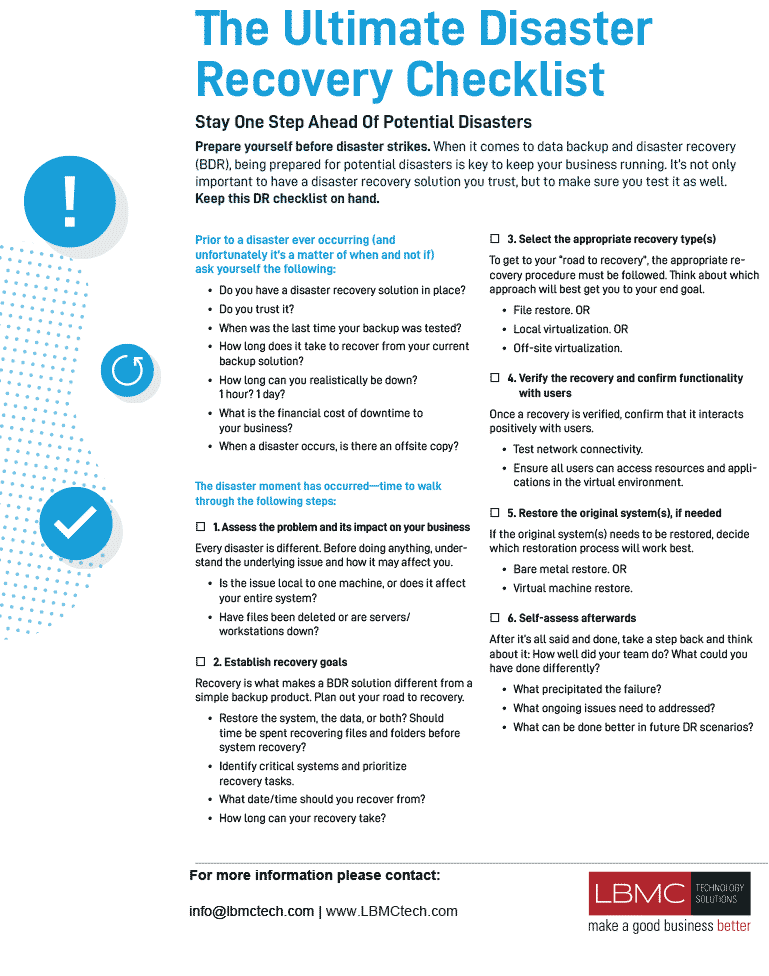If you don’t have a disaster recovery or business continuity plan, now is the time to evaluate how well your business would stand up to a natural disaster. Put this as a priority for your company if you don’t have a plan in place. If you are unsure of where to start, keep reading below for a few key things to keep in mind.
Disaster Preparedness and Response
A key to any successful disaster plan is awareness. First and foremost is the awareness of different types of disasters. Disaster preparedness and response can differ depending on the type of event. Hurricanes, tornadoes, fire and flood may all have different levels and requirements for preparedness. The response for some may be the same, but understanding each is critical to maintaining a successful Disaster Business Resumption Plan.
For example, the period of time for a significant hurricane to form, develop, and reach landfall is typically many days, and sometimes weeks. This allows for a tiered approach to planning that should begin at seven days prior to expected landfall, and progress to end progress to end preparation activities at 24 hours prior to the expected event.
In contrast, severe weather and tornados form quickly, and the time to prepare for a severe event is typically shorter. As with hurricane and tropical storm preparedness, awareness and response are critical in a successful plan.
Business continuity and disaster recovery planning is crucial to recovery in the event of a major disaster. A detailed, documented approach during planning and subsequent exercises could result in less pressure to create a solution in an already stressful environment.
Prepare for the complete destruction of your technology infrastructure.
- Identify key infrastructure and components that would be required by location in the event of a natural disaster.
- Determine power shutdown sequence for core IT assets
- Have complete backups for data, applications and any other critical piece of your organization in an off-site location
- Establish pipelines with vendors/suppliers for critical replacement components by location
- Ensure on-demand availability of failover IT infrastructure offsite or cloud-based
- Ensure on-demand availability of failover voice/fax call switching
Prepare for displacement of your business temporarily or even permanently.
It is important to be prepared for extended or permanent building damage.
- Arrange to have incoming calls rerouted to an alternative site or to employee’s cell phones
- Complete backups for data, applications or any other critical piece of your organization in an off-site location
- Have an emergency notice prepared for the company website that can be activate remotely and modified as restorations are being made
- Consider alternate recovery sites outside the region in the event that nearby primary recovery sites have been compromised or are booked beyond capacity.
Prepare to help your customers and partners get through regional disasters.
In addition to protecting and restoring your own operations, you should be prepared to help your customers and partners get through any regional disasters. Storms such as hurricanes, tornadoes, or severe weather with flooding could put a data center out for weeks, months or even permanently if building damage occurs; therefore, it is important to be prepared.
- Complete backups for data, applications or any other critical piece of your organization in an off-site location
- Have an emergency notice prepared for the company website that can be activate remotely and modified as restorations are being made
- Cover and protect vital documents and electrical equipment from potential wind-driven rain, which may breach the building envelope through windows, doors and roof systems
- Have a plan to restore IT operations in the cloud or at a site safely away from the threat of these storms. This restoration may require the evacuation of your key IT personnel, or have remote personnel available to work remotely as the area’s mobile data services are interrupted
- It is important to ensure that your insurance policy will cover all aspects of continuing their business operations, not just repairing physical losses
- The loss of essential records, files and other materials is common and can not only add to your damage costs, but also delay your return to normal operations. FEMA recommends to take the following steps to reduce vulnerability:
- Raise computers above flood level and move them away from large windows
- Moving heavy and fragile objects to low shelves
And, as always:
- Arrange to have incoming calls rerouted to an alternative site or to employee’s cell phones
- Complete backups for data, applications or any other critical piece of your organization in an off-site location
- Have an emergency notice prepared for the company website that can be activate remotely and modified as restorations are being made
LBMC Technology Solutions is committed to helping our customers prepare for anything that comes their way. If you would like to get more information about preparing for disasters (of any kind) please contact us today.
Click the image to download a printable checklist.Download The Ultimate Disaster Recovery Checklist (PDF)

